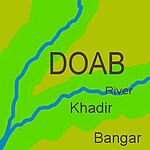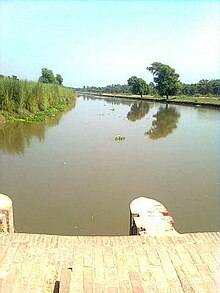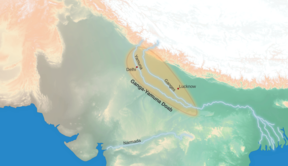Doab
Doab | |
|---|---|
Natural region | |
 A map showing the differentdoabsin the northern subcontinent | |
| Region | Indian subcontinent |
Doab(English:/ˈdoʊɑːb/) is a term used inSouth Asia[1]for the tract[2][1]of land lying between twoconfluentrivers. It is similar to aninterfluve.[3]In theOxford Hindi-English Dictionary,R. S. McGregordefines it as from Persiando-āb(دوآب,literally "two [bodies of] water" ) "a region lying between and reaching to the confluence of two rivers."
Khadir, bangar, barani, nali and bagar
[edit]
SinceNorth IndiaandPakistanare coursed by a multiplicity of Himalayan rivers that divide the plains intodoabs(i.e. regions between two rivers), theIndo-Gangetic plainsconsist of alternating regions of river,khadirandbangar.The regions of thedoabsnear the rivers consist of low-lying,floodplains,but usually, very fertilekhadirand the higher-lying land away from the rivers consist ofbangar,less prone to flooding but also less fertile on average.[4][5]
Khadir is also callednaliornaili,specially in northern Haryana the fertileprairietract between theGhaggarriver and the southern limits of theSaraswati channel depressionin that gets flooded during the rains.[6]
Within bangar area, thebaraniis any low rain area where the rain-fed dry farming is practiced, which nowadays are dependent on the tubewells for irrigation.[7]Bagar tract,an example of barani land, is the dry sandy tract of land on the border of Rajasthan state adjoining the states of Haryana and Punjab.[7]Nahriis anycanal-irrigated land,[6]for example, theRangoi tractwhich is an area irrigated by theRangoi channel/canalmade for the purpose of carrying flood waters of Ghagghar river to dry areas.[8][9]
Historically, villages in thedoabshave been officially classified askhadir,khadir-bangar(i.e. mixed) orbangarfor many centuries, and different agricultural tax rates applied based on a tiered land-productivity scale.[10][11]
The Doab
[edit]The Doabdesignates the flat alluvial tract between theGangesandYamunarivers extending from theSivalik Hillsto the two rivers' confluence atPrayagraj.It is also called asGanges-Yamuna DoaborGanga Doab.The region has an area of about 23,360 square miles (60,500 square km); it is approximately 500 miles (805 km) in length and 60 miles (97 km) in width.[12]
TheBritish rajdivided theDoabinto three administrative districts, viz., Upper Doab (Meerut), Middle Doab (Agra) and Lower Doab (Prayagraj).[12][citation needed]
Currently the following states and districts form part ofThe Doab:[12]
Upper Doab
[edit]Saharanpur,Shamli,Muzaffarnagar,Baghpat,Meerut,Ghaziabad,Hapur,Gautam Buddh NagarandBulandshahr
Central or Middle Doab
[edit]Etah,Kasganj,Aligarh,Agra,Hathras,Firozabad,MainpuriandMathurais in the trans-Yamuna region ofBraj.
Lower Doab
[edit]Farrukhabad,Kannauj,Etawah,Auraiya,Kanpur(Urban & Rural),Fatehpur,KaushambiandAllahabad.[13]
The Punjab Doabs
[edit]
| Part ofa serieson |
| Punjabis |
|---|
 |
 Punjab portal |
Each of the tracts of land lying between the confluent rivers of thePunjab regionof Pakistan and India has a distinct name, said to have been coined by RajaTodar Mal,a minister of theMughalemperorAkbar.The names (except for "Indus Sagar" ) are a combination of the first letters, in the Persian Alpha bet, of the names of the rivers that bound the Doab. For example, "Chaj" (چج) =Chanāb (چناب,"Chenab" ) +Jehlam(جہلم,"Jhelum" ). The names are from east to west.[citation needed]
Indus Sagar Doab
[edit]TheIndus Sagar Doablies between theIndusandJhelumrivers.[citation needed]
Chaj Doabs
[edit]TheChaj Doablies between theJhelumand theChenabrivers.[citation needed]
Rachna Doabs
[edit]TheRachna Doab(considerable portion of the Rechna Doab isMajha[14]) lies between theChenaband theRavirivers.[citation needed]
Bari Doabs
[edit]TheBari Doab(considerable portion of the Bari Doab isMajha[14]) lies between theRavi,BeasandSutlejrivers.[citation needed]
Bist Doab
[edit]TheBist Doab(orDoaba) - between theBeasand theSutlejrivers.[citation needed]
Other doabs
[edit]Raichur Doab
[edit]TheRaichur Doabis the triangular region ofAndhra PradeshandKarnatakastates which lies between theKrishna Riverand its tributary theTungabhadra River,named for the town ofRaichur.[citation needed]
See also
[edit]- Ap (water)
- Interamnia,an ancient Latin placename, meaning "between rivers"
- Mesopotamia,in Ancient Greek:Μεσοποταμία'[land] between rivers'.
Notes
[edit]- ^abdoab or duab, n.,OED Online, Oxford University Press, March 2014,retrieved24 April2019Quote: "Originally and chiefly in South Asia: (the name of) a strip or narrow tract of land between two rivers; spec. (with) the area between the rivers Ganges and Jumna in northern India."
- ^doab or duab, n.,OED Online, Oxford University Press, March 2014,retrieved24 April2019Quote: "confluence, land between two rivers, used in India of the tongue of land between the Ganges and Jumna, and of similar tracts in the Punjab, etc., lit. ‘two waters’"
- ^Doab.,Webster's Third New International Dictionary, Unabridged., 2013,retrieved24 April2019Quote: "a tract of land between two rivers: interfluve"
- ^Pakistan: Soils,Encyclopædia Britannica, 2010,
... khaddar soils. Away from the river, toward the middle of the doabs, older alluvial soils (called bangar) are widely distributed...
- ^Damage to Yamuna Khadar, Ravi Shankar's Art of Living Responsible: NGT,Khas Khabar.7 Dec 2017.
- ^ab"The imperial gazeteers of India, 1908",British Raj,page 288.
- ^abE. Walter Coward, 1980,"Irrigation and Agricultural Development in Asia: Perspectives from the social sciences",Cornell Universitypress,ISBN0801498716.
- ^1987,"gazetteer of India: Hisar District"Archived1 May 2014 at theWayback Machine,page 7.
- ^1987,"Gazeteers of Hisar district, 1987"Archived7 November 2017 at theWayback Machine,Government of Haryana,page 162.]
- ^F.C. Channing (1882),Land Revenue Settlement of the Gurgaon District,Government of India,
... The rates here applied were the same as those applied in the Bangar and Khadar circles and the same comparisons hold good...
- ^Oswald Wood, R. Maconachie (1882),Final report on the settlement of land revenue in the Delhi District,Government of India, 1882,
... The Khadar-Bangar chak lies along the river; 37 villages are purely Khadar and 39 partly Khadar partly Bangar. The villages nearest the river are subject to inundations, but where the water runs off in time, the natural fertility of the...
- ^abcGanges-Yamuna Doab,Encyclopedia Britannica.
- ^"Archaeology Of Lower Ganga-Yamuna Doab 2 Volumes".
- ^abKakshi, S.R.; Pathak, Rashmi; Pathak, S.R.Bakshi R. (2007-01-01). Punjab Through the Ages. Sarup & Sons.ISBN978-81-7625-738-1.Retrieved 12 June 2010.
References
[edit]- McGregor, Ronald Stuart(1993),The Oxford Hindi-English Dictionary,Oxford University Press, p. 513,ISBN978-0-19-864339-5,retrieved11 September2013
- Doabs of Punjab, Pakistan
- Geography of Haryana
- Geography of Madhya Pradesh
- Geography of Punjab, India
- Geography of Punjab, Pakistan
- Geography of Rajasthan
- Geography of Uttar Pradesh
- Regions of Haryana
- Regions of Madhya Pradesh
- Regions of Punjab, India
- Regions of Punjab, Pakistan
- Regions of Rajasthan
- Regions of Uttar Pradesh
- Persian words and phrases
- Natural regions of Asia
- Landforms


